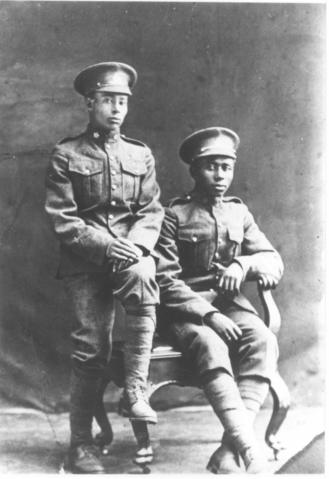Anna Greenup (Anne or Annie, née Hurd), co-founder and first president of the Coloured Women’s Club of Montreal, schoolteacher (born 5 May 1874 in Harveysburg, Ohio; died 15 March 1952 in Vernon, BC). She helped found the first Black women’s organization in Canada in 1902 and served as its president. (See also Black Canadians.)
Childhood in the United States
Anna Hurd was born May 1874 in Harveysburg, a small abolitionist village that was the site of the first free school for Black children in Ohio. She is the youngest daughter of Mahala Jackson and Charles Hurd, a schoolteacher, minister and Civil War veteran ( See American Civil War and Canada.) Anna attended school until she was 14, then worked for as a schoolteacher for several years. Four of her siblings (Robert, Caroline, Florence and Granville) worked in the same profession. The Hurd family moved to different towns in Ohio, then to Knoxville, Tennessee.
Community Involvement in Montreal
In December 1900, Anna Greenup married Charles Harvey Greenup in Essex, Ontario. Like many Black men who were dealing with a segregated job market, he had a variety of jobs in the railway industry: cook, attendant, and sleeping car porter. Many years later, Anna explained that "he did a little bit of everything on the railroad when I met him."
The couple moved to the Montreal community of Faubourg Saint-Antoine, known today as Petite-Bourgogne. (See Little Burgundy and Montreal's Black English-Speaking Community.) This was the neighbourhood where many English-speaking Black families settled, particularly because of its proximity to the railroad station where sleeping car porters worked. ( See also Black History in Canada: 1900 to 1960.)
At the time, Black people suffered significantly from discrimination in employment, housing, businesses, places of worship and access to services. Black women also could not get involved in organizations run by white women. Faced with the great needs of their community, seven African American women got together in 1902 to create the Women’s Club of Montreal, which became the Coloured Women’s Club of Montreal (CWCM) in 1904. Although this was the first Black women’s organization in Canada, it followed in the footsteps of the National Association of Colored Women, founded in the United States in 1896.
Greenup was chosen as the first president of CWCM and, under her leadership, the association offered a variety of community supports. From its early years, CWCM organized the reception and housing of Boer War veterans, set up soup kitchens and distributed clothing and blankets to immigrants of Caribbean and African-American origin. (See Immigration to Canada.)
As of 1907, several members of CWCM helped found the Union Congregational Church (known today as the Union United Church), the first large church for Montreal’s Black community.

Women played a key role in this community action, because their spouses were away for long periods working on the trains.
According to historian Dorothy W. Williams,
the CWCM and the Union Congregational Church “are unique Black institutions that set the stage for the development of community awareness while serving as a model for navigating the prevailing trend of racial segregation and discrimination during the early 20th-century society.”
Move to Vancouver and End of Her Life
Around 1910, Anna Greenup moved from Montreal to Vancouver where her husband took a job as an inspector for the Canadian Pacific Railway. However, he died in 1920. The couple only had one child who died of illness at around six months.
From 1911 to 1931, Greenup lived in the West End neighbourhood. Although this area was not as central to the Black community as Hogan’s Alley, it was home to several important organizations including the Universal Negro Improvement Association and the Endeavor Club, a Vancouver chapter of the Washington State Federation of Colored Women’s Clubs.
In her new city, Greenup continued her community involvement. She was an active member of the First Baptist Church and took part in several events of the Women’s Mispah Bible class. In 1927, she was elected head of social activities.
Over the next few years, she experienced physical health problems and cognitive loss, and began to isolate herself. Without family to care for her in Vancouver, Greenup was admitted to the Essondale psychiatric hospital in December 1931 at the request of her brother Granville Hurd. She received a few visitors, including Rosa Pryor, a restaurateur and the first Black woman to own a business in Vancouver.
In July 1948, Greenup was admitted to a provincial home for the elderly in Vernon, British Columbia. She remained there until her death from cancer on 15 March 1952. She was buried at Pleasant Valley Cemetery in Vernon.
Heritage
The Coloured Women’s Club of Montreal, which still exists today, plays an important role in ensuring that Anne Greenup’s contribution to Montreal’s Black community is recognized and honoured.
Although Greenup had no descendants of her own, her niece Elsie Lam (née Elsie Hurd) continued her work, becoming president of the Coloured Women’s Club of Montreal in the late 1950s.
Greenup’s home in Vancouver, where she lived from 1920 to 1931, was integrated into a cooperative housing project in 1985.
In 1997, Quebec's Ministère des Relations avec les Citoyens et de l'Immigration created the Anne-Greenup Solidarity Prize. The award is presented annually to an individual or organization that has distinguished itself in the fight against racism and in promoting civic action.
Habitations Anne-Greenup, which offers 26 new social housing units, was inaugurated in Montreal’s Sud-Ouest borough in 2004.

 Share on Facebook
Share on Facebook Share on X
Share on X Share by Email
Share by Email Share on Google Classroom
Share on Google Classroom


